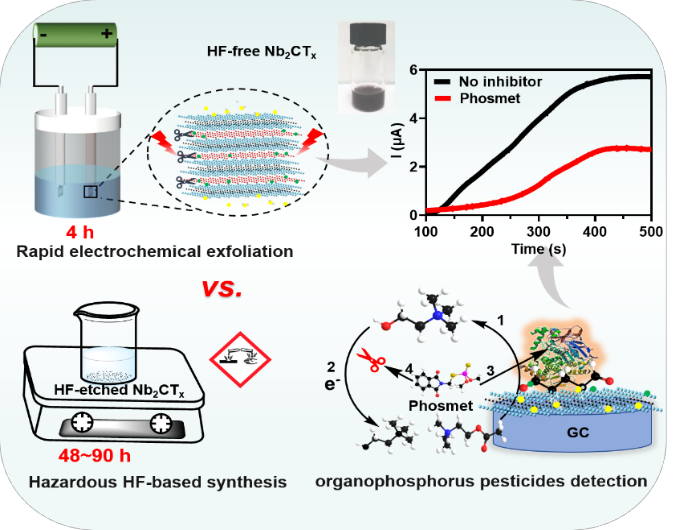
hotline:
17715390137
Tel/Wechat:
18101240246 (Technology)
0512-68565571
Email:mxenes@163.com (Sales Engineer)bkxc.bonnie@gmail.com
Scan the code to follow or search the official account on WeChat:
2D Materials Fronrier After paying attention,
click on the lower right corner to contact us,
Enter enterprise WeChat.
Professional Services Online

MXenes is a new class of two-dimensional materials composed of transition metal carbides or nitrides. It has high electrical conductivity, good hydrophilicity, excellent optical properties and mechanical properties. MXene can be widely used in many fields, such as electrochemical catalysis, biomedicine, energy conversion and storage, etc. The traditional method of preparing MXene is to selectively etch away the A layer (usually IIIA/IVA elements, such as Al) in MAX by using high-concentration hydrofluoric acid (HF) or in-situ formation of hydrofluoric acid. So far, more than 20 different types of MXene have been obtained through experimental methods, and more than 70 kinds of MXene have been predicted theoretically. Among these different MXene composites, niobium carbide (Nb2CTx) has excellent performance in terms of metal properties due to the flexible properties of functional groups. Nb2CTx has almost no band gap, and has hydrophilicity and other unique physical and chemical properties, which is different from other traditional 2D materials. Nb2CTx is expected to be used in the fields of lithium-ion energy storage, dye adsorption and tumor imaging. However, research on applications in biomedicine, especially in the field of biosensing,is extremely rare. The fundamental reasons leading to this research situation can be summarized as follows: (1) The synthesis time of Nb2CTx is long, and the synthesis environment is dangerous, requiring exposure to highly corrosive high-concentration (50%) hydrofluoric acid environment, reaction 48 -90 hours makes the preparation method of MXene full of challenges, and also increases the complexity of the process to a certain extent; (2) Although previously reported to synthesize MXene by HF or in-situ HF etching methods, these methods have not been able to extend To be used in the preparation of Nb2CTx. The reason is that the "A" element cannot be completely etched away; (3) Due to the excessive use of hydrofluoric acid, the F-residues on the surface cause the release of HF through hydrolysis or electrochemical reactions. The released HF will reduce enzyme activity and have potential toxicity to normal cells, which greatly hinders the further exploration of Nb2CTx in biomedical applications; (4) The surface functional groups of Nb2CTx etched by hydrofluoric acid are highly reactive. It is easily oxidized in the natural environment or during the oxygen release reaction (OER) process, which seriously affects the stability and effectiveness of Nb2CTx in the biosensing process. Therefore, from the perspective of biomedical systems, it is urgent to develop a safe and stable method for synthesizing fluorine-free Nb2CTx nanosheets.

Recently, the research group of Professor Jianhua Hao of the Hong Kong Polytechnic University used electrochemical etching (E-etching) to prepare a new type of fluorine-free Nb2CTx nanosheet. By using this electrochemical etching method to quickly etch aluminum (4 hours), the research group was able to prepare fluorine-free niobium carbide MXene with good chemical stability and biocompatibility. Based on these advantages, this study constructed a Nb2CTx/acetylcholinesterase fluorine-free biosensor for the detection of the organic pesticide imidophos, with a detection limit of 0.046 ng mL−1. Compared with the Nb2CTx biosensor based on traditional hydrofluoric acid etching, the fluorine-free Nb2CTx biosensor has better performance, indicating that the fluorine-free Nb2CTx MXene can improve the enzyme activity and electron transfer ability of the biosensor.
This fluorine-free MXene biosensor with ultra-high sensitivity and high selectivity has potential application prospects in the detection of small molecules of pesticides. This stable and excellent biocompatible fluorine-free MXene nano-platform is expected to be extended to other biomedical fields. Related papers are published in Advanced Science (DOI: 10.1002/advs.202001546).
Information source: MaterialsViews
This information is from the Internet for academic exchanges. If there is any infringement, please contact us and delete it immediately

| Reminder: Beijing Beike New Material Technology Co., Ltd. supplies products only for scientific research, not for humans |
| All rights reserved © 2019 beijing beike new material Technology Co., Ltd 京ICP备16054715-2号 |